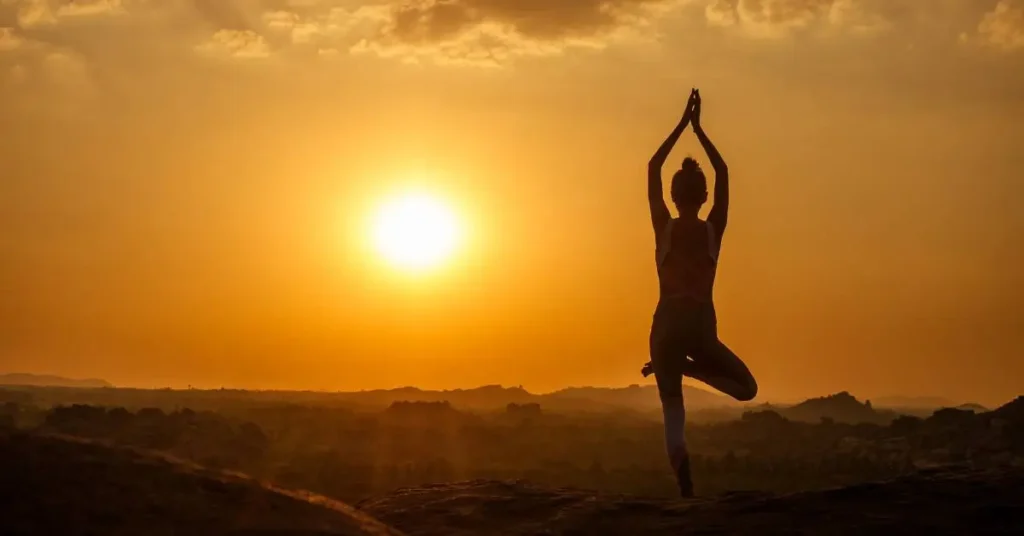In Sanskrit, the word surya means sun, and namaskar means salutation or greeting. Surya Namaskar, which means Salutation offered to the Sun, is an ancient yoga practice.
It combines a series of 12 postures, with each step followed by a particular breathing technique. Additionally, each position is associated with a different Surya Namaskar Mantra.
It is a holistic approach to fitness and well-being that encompasses physical, mental, and spiritual aspects. In this article, we will delve into the origins, benefits, step-by-step instructions as well as some frequently asked questions about Surya Namaskar.
Table of contents
- Origins and Significance of Surya Namaskar
- Physical Benefits of Surya Namaskar
- Mental and Emotional Benefits of Surya Namaskar
- Step-by-Step Guide to Surya Namaskar
- Surya Namaskar Mantra
- Tips for a Successful Surya Namaskar Practice
- Precautions and Contraindications
- Conclusion
- FAQs (Frequently Asked Questions)
Origins and Significance of Surya Namaskar
Surya Namaskar finds its roots in ancient Indian traditions and, consequently, it is an integral part of yoga.
Its mythological reference is found in the Ramayana and some people hold the opinion that Lord Hanuman’s attempt to consume the Sun after mistaking it for a fruit is where the custom of bowing before the Sun first began.
When Lord Hanuman realized the harm he had caused, he prostrated himself in penance before Lord Surya (Sun God) to seek forgiveness.
This practice is a way of expressing gratitude to the sun, and therefore, it is considered a symbol of vitality and life force. It combines physical movements, controlled breathing as well as mindfulness to create a harmonious mind-body connection.
Physical Benefits of Surya Namaskar

Surya Namaskar offers numerous physical benefits like:
- Surya Namaskar stretches and tones up all the muscles of the body.
- It increases your vitality.
- It also strengthens the immunity of the body.
- Overall body Strength is also increased by Surya Namaskar.
- The synchronized movements help in improving blood circulation.
- Surya Namaskar also stimulates the digestive system and detoxifies the body.
- It helps in keeping you disease free and healthy.
- Regular Surya Namaskar practice can also aid in weight management and promote a healthy cardiovascular system.
Mental and Emotional Benefits of Surya Namaskar

In addition to its physical benefits, Surya Namaskar also has a positive influence on mental and emotional well-being.
- The practice promotes clarity of mind.
- It also reduces stress and anxiety and helps calm the mind.
- Regular practice increases mindfulness and enhances overall mental resilience.
- It also helps in boosting confidence.
Step-by-Step Guide to Surya Namaskar
1. Namaskarasana (Prayer Pose)
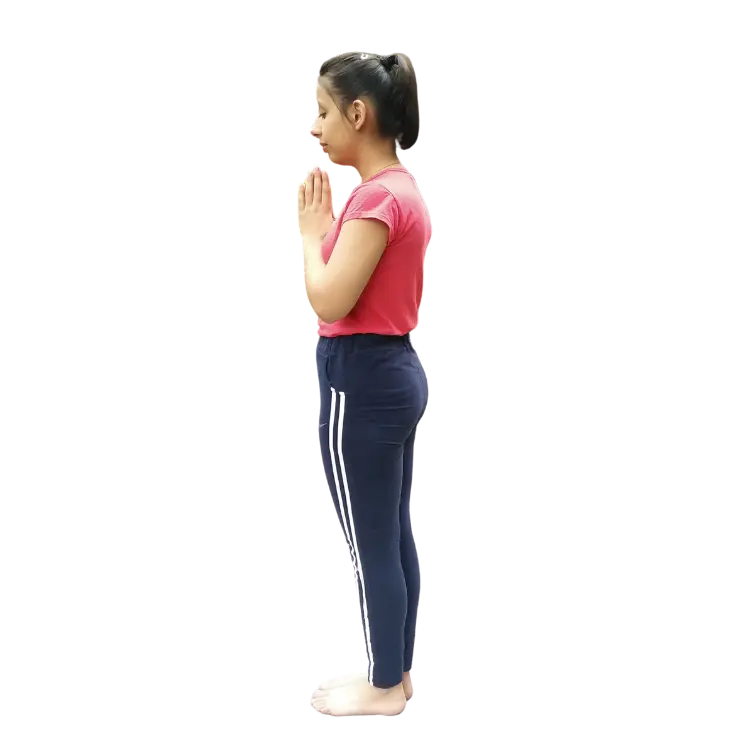
Position yourself at the edge of your yoga mat, while ensuring that your feet are together and you evenly distribute your weight on both feet.
Open up your chest and let your shoulders relax. Then begin to inhale deeply as you raise both arms up from the sides, and as you exhale, bring your palms together in front of your chest, forming a prayer position.
And now you are in Namaskarasana or Prayer Pose.
2. Hasta Uttanasna (Raised Arms Pose)
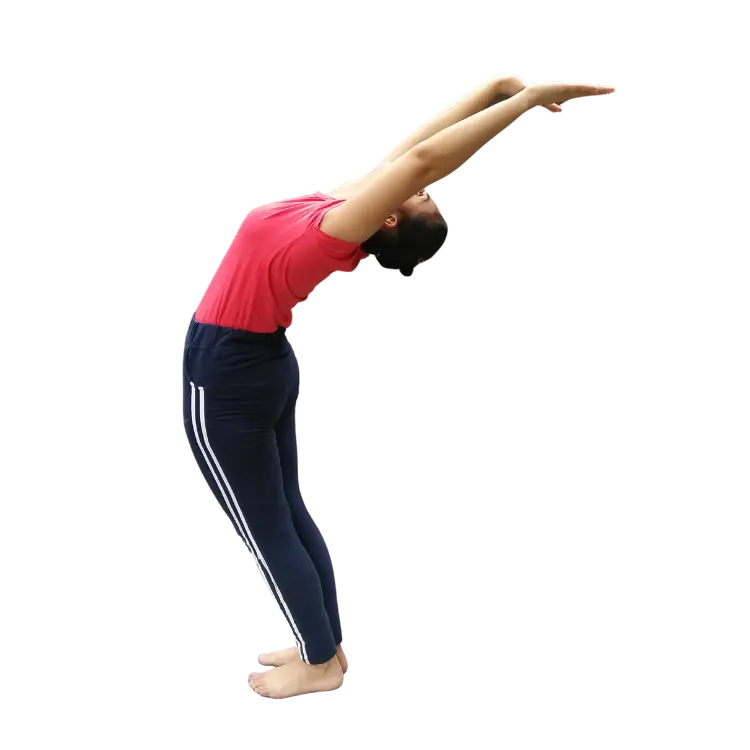
Now to move forward in the process, inhale deeply and lift your arms overhead while gently bending backward and looking up toward your hands.
This position is known as Hasta Uttanasna or Raised Arms Pose.
3. Padhastasana (Standing Forward Bend)
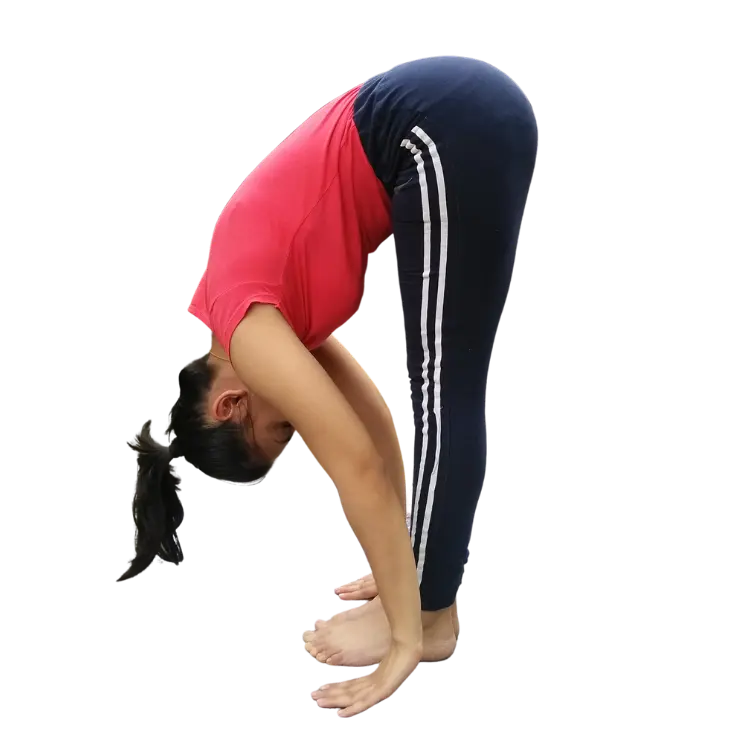
In the third step, exhale and bend forward from the lower back while bringing your hands to the floor beside your feet. Allow your head and neck to relax, and meanwhile, let gravity pull you deeper into the stretch.
4. Ashwa Sanchalanasana (Equestrian Pose)
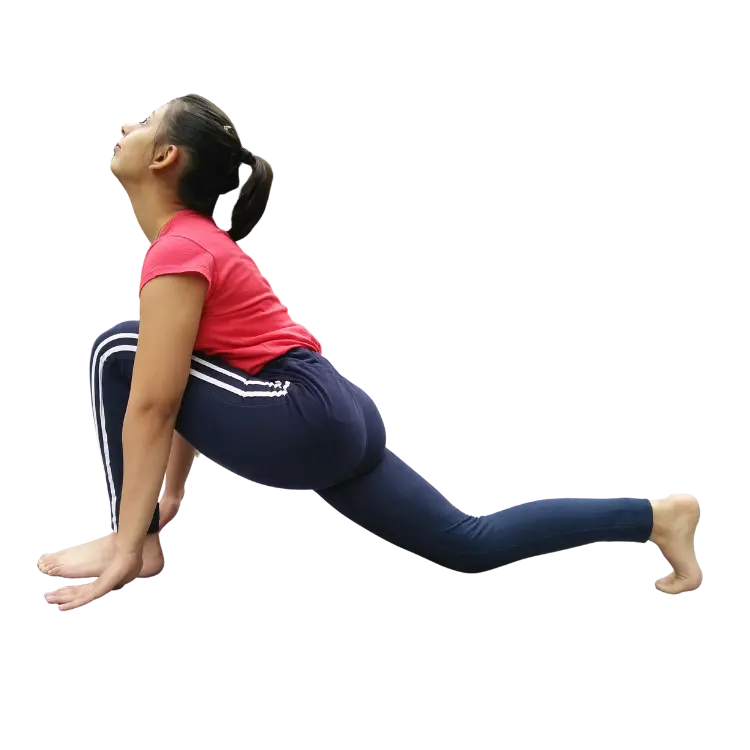
Next, take a deep breath in and move your right leg backward into a lunge position. Place your hands on the floor while framing your left foot. Then curve your back and direct your gaze slightly upwards to get into Equestrian Pose or Ashwa Sanchalanasana.
5. Parvatasana (Mountain Pose)
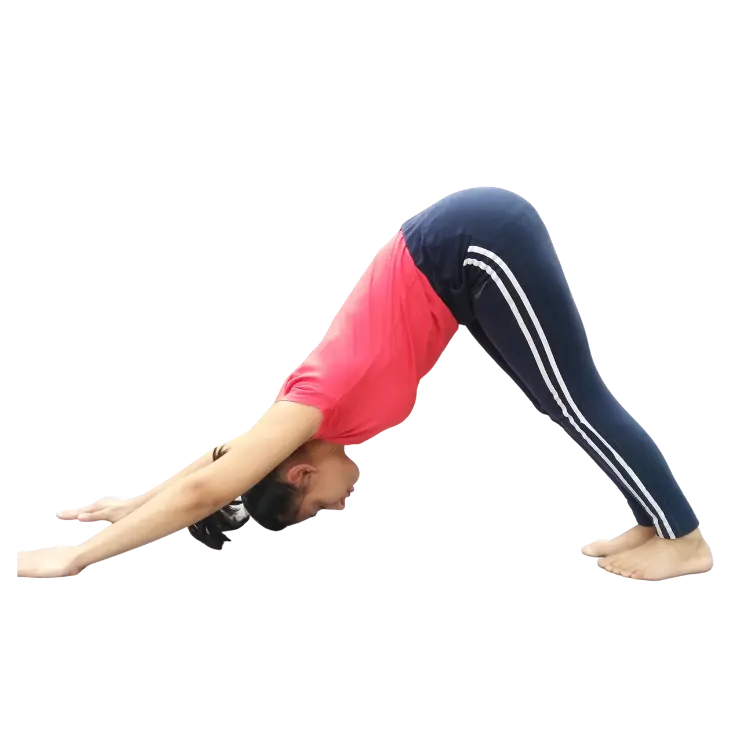
After Equestrian Pose or Ashwa Sanchalanasana, exhale and step your left leg back while lifting the hips and the tailbone up to bring the body into an inverted ‘V’ pose also known as Parvatasana or Mountain Pose.
6. Ashtanga Namaskara (Salute with Eight Parts Pose)

Moving Forward, gently bring your knees, chest, and chin down to the floor while ensuring that your elbows are kept close to your sides.
In this pose our eight parts are touching the ground and hence it is called Ashtanga Namaskara or Salute with Eight Parts Pose.
7. Bhujangasana (Cobra Pose)
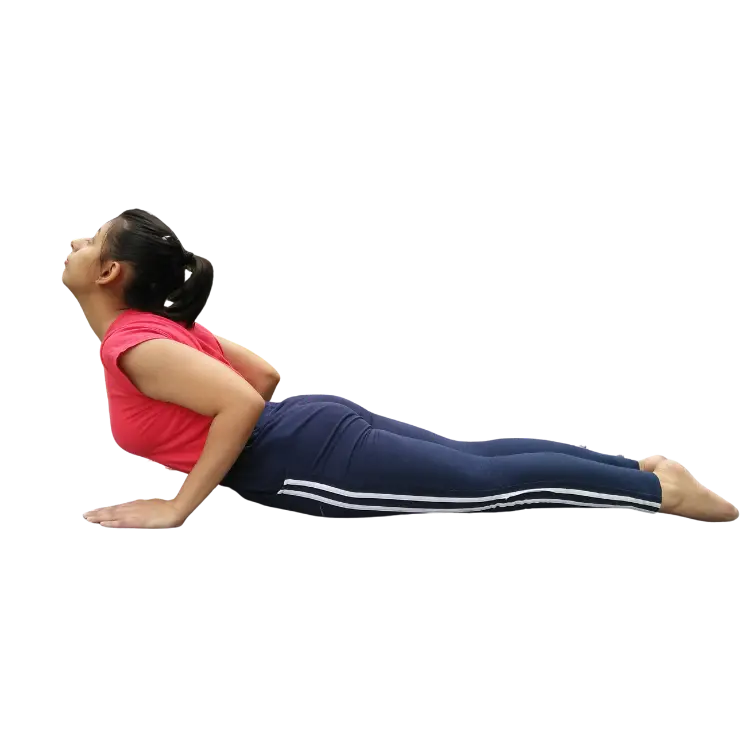
For the next pose, you need to inhale and slide forward while rolling over your toes. Lift your chest off the floor to your navel and press the tops of your feet into the mat, while looking upward. And now you are in Cobra Pose or Bhujangasana.
8. Parvatasana (Mountain Pose)

Moving on, we return to Parvatasana or Mountain Pose as seen in the fifth step. Exhale and lift your hips up and back, forming an inverted V shape with your body while pressing your palms into the floor, extending your arms, and lengthening your spine.
9. Ashwa Sanchalanasana (Equestrian Pose)

Going into the reverse order, after mountain pose, we now move on to Equestrian Pose or Ashwa Sanchalanasana. Inhale while stepping with your right foot forward, returning to the lunge position. Keep your hands on the floor while framing your right foot, and try to look up.
10. Padhastasana (Standing Forward Bend)

The tenth pose in the process will be returning to Padhastasana or Standing Forward Bend. While exhaling, bring your left foot forward to meet your right foot. Fold forward from the hips, allowing your hands to reach toward the ground or you can also grasp your ankles.
11. Hastuttanasana (Raised Arms Pose)

In the last-second pose, inhale deeply as you sweep your arms out to the sides and overhead. Arch your back slightly and look up towards your hands while returning back into Hastuttanasana or Raised Arms Pose.
12. Namaskarasana (Prayer Pose)

In the end, exhale and bring your palms together in front of the chest in a prayer position also known as Namaskarasana. And now, as a result, you have completed the full practice of Surya Namaskar or Sun Salutation.
Here are all the 12 Surya Namaskar Steps or Surya Namaskar Poses:
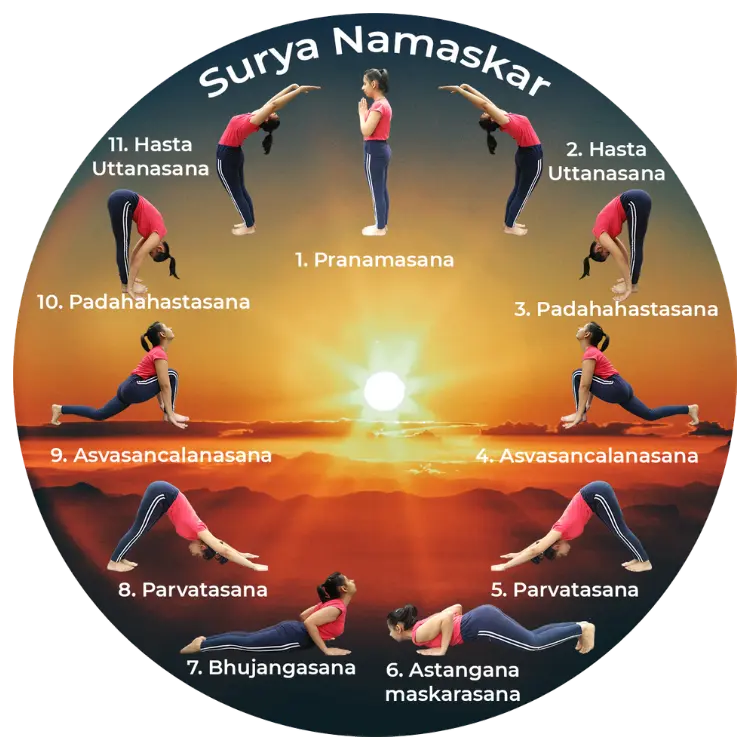
Surya Namaskar Mantra
Here are all the Surya Namaskar Mantras associated with their respective asanas. Along with that, you can find the meaning of each Mantra and the Chakra associated with it.
| Asana | Surya Namaskar Mantra | Meaning | Chakra |
|---|---|---|---|
| Pranamasana | ॐ मित्राय नमः | Affectionate to all | Anahata |
| Hast Uttanasana | ॐ रवये नमः | Cause of all changes | Vishudddhi |
| Padhastasana | ॐ सूर्याय नमः | Who induces all activity | Swadhishthan |
| Ashvasanchalan asana | ॐ भानवे नमः | Who diffuses light | Ajna |
| Parvatasana | ॐ खगाय नमः | Who moves in the sky | Vishuddhi |
| Ashtangnamaskar asana | ॐ पूष्णे नमः | Who nourishes all | Manipur |
| Bhujangasana | ॐ हिरण्यगर्भाय नमः | Who contains everything | Swadhishthan |
| Parvatasana | ॐ मरीचये नमः | Who possesses raga | Vishuddhi |
Asanas and their Surya Namaskar Mantra in English along with their meaning:
Yoga Asana: Pranamasana (Prayer Pose)
Mantra: Om Mitraaya Namaha
Meaning: One who is friendly to all.
Yoga Asana: Hastauttanasana (Raised Arms Pose)
Mantra: Om Ravaye Namaha
Meaning: The shining or the radiant one.
Yoga Asana: Hastapadasana (Standing Forward Bend)
Mantra: Om Suryaya Namaha
Meaning: The one who eliminates darkness and is accountable for initiating activity.
Yoga Asana: Ashwa Sanchalanasana (Equestrian Pose)
Mantra: Om Bhaanave Namaha
Meaning: One who illuminates or the bright one.
Yoga Asana: Parvatasana (Mountain pose)
Mantra: Om Khagaya Namaha
Meaning: The omnipresent entity who traverses the skies.
Yoga Asana: Ashtanga Namaskara (Salute with Eight Parts Pose)
Mantra: Om Pooshne Namaha
Meaning: Giver of nourishment and fulfillment
Yoga Asana: Bhujangasana (Cobra Pose)
Mantra: Om Hiranya Garbhaya Namaha
Meaning: One who has a golden-colored brilliance.
Yoga Asana: Parvatasana (Mountain Pose)
Mantra: Om Mareechaye Namaha
Meaning: Giver of light with infinite rays.
Yoga Asana: Ashwa Sanchalanasana (Equestrian Pose)
Mantra: Om Aadityaaya Namaha
Meaning: The son of Aditi, the cosmic divine mother.
Yoga Asana: Padhastasana (Standing Forward Bend)
Mantra: Om Savitre Namaha
Meaning: One who is responsible for life.
Yoga Asana: Hastauttanasana (Raised Arms Pose)
Mantra: Om Arkaaya Namaha
Meaning: One who is worthy of praise and glory
Yoga Asana: Pranamasana (Prayer Pose)
Mantra: Om Bhaskaraya Namaha
Meaning: Giver of wisdom and cosmic illumination.
Tips for a Successful Surya Namaskar Practice

- Start with a warm-up to prepare your body for the practice.
- Focus on synchronizing your breath with each movement.
- Practice regularly to experience the full benefits of Surya Namaskar.
- Pay attention to your body and make adjustments to the poses if necessary.
- Consult a certified yoga instructor for guidance, particularly, to ensure correct alignment.
Precautions and Contraindications
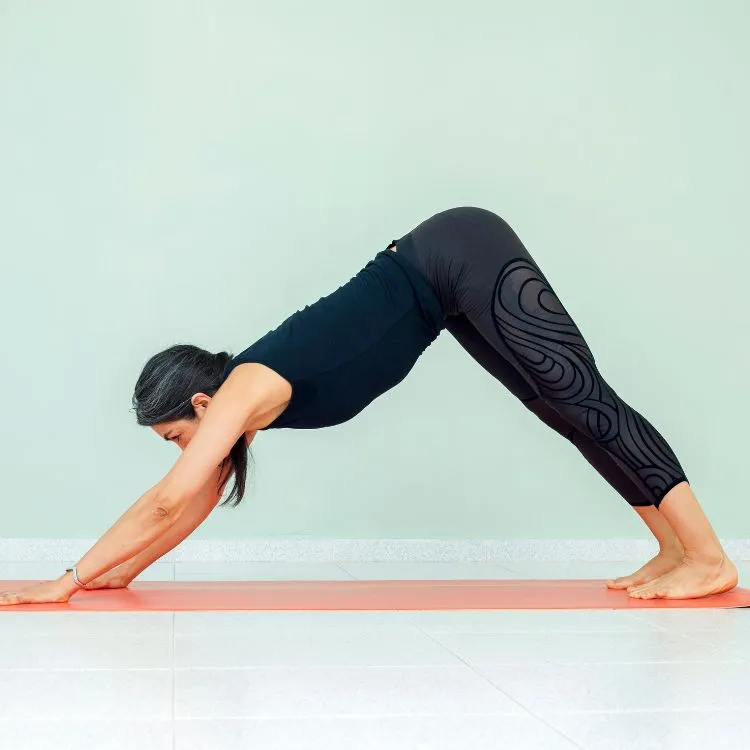
While Surya Namaskar is generally safe for most individuals, it is essential to take some precautions.
- Before performing Surya Namaskar a suitable warm-up should be performed.
- Breathing should be correctly in sync with the asanas/poses.
- Individuals with high blood pressure should approach the practice with the guidance of a professional.
- Pregnant ladies and people with Slip Discs or severe back pain should avoid it.
- It should be practiced empty stomach or with a 3-hour gap after the meal.
Conclusion
Surya Namaskar, also known as Sun Salutation, is a powerful yoga practice that offers numerous benefits for the mind, body, and spirit. Furthermore, by incorporating a series of postures and controlled breathing, it provides a holistic approach to health and well-being.
This practice can be adapted to suit your needs and abilities, whether you are a beginner or an experienced practitioner.
Embrace this ancient practice and experience the transformative effects it can have on your overall fitness and inner harmony.
FAQs (Frequently Asked Questions)
Q. Is Surya Namaskar suitable for beginners?
A. Surya Namaskar can be practiced by beginners, but it is advisable to start slowly and gradually increase the intensity and number of rounds.
Q. How many rounds of Surya Namaskar should I do?
A. The number of rounds can vary depending on your fitness level and time availability. Initially, it is recommended to start with a few rounds. As you progress, you can gradually increase to 12 or more rounds.
Q. Can Surya Namaskar help with weight loss?
A. Yes, Surya Namaskar can aid in weight loss by boosting metabolism, increasing calorie burn, and toning the muscles. However, it should be combined with a healthy diet and overall active lifestyle.
Q. What is the best time to practice Surya Namaskar?
A. The best time to practice Surya Namaskara is during sunrise. It can also be practiced in the evening but with the condition that the practitioner should have a light or an empty stomach.
Q. Can Surya Namaskar be practiced by people of all ages?
A. Surya Namaskar can be modified to suit individuals of different age groups and fitness levels. It is important to listen to your body as well as practice with proper alignment and seek guidance if necessary.
Finally, Incorporating Surya Namaskar into your daily routine can embark you on a journey of self-discovery, physical well-being, and inner peace. By embracing the power of the sun, let Surya Namaskar illuminate your path to a healthier and more fulfilling life.
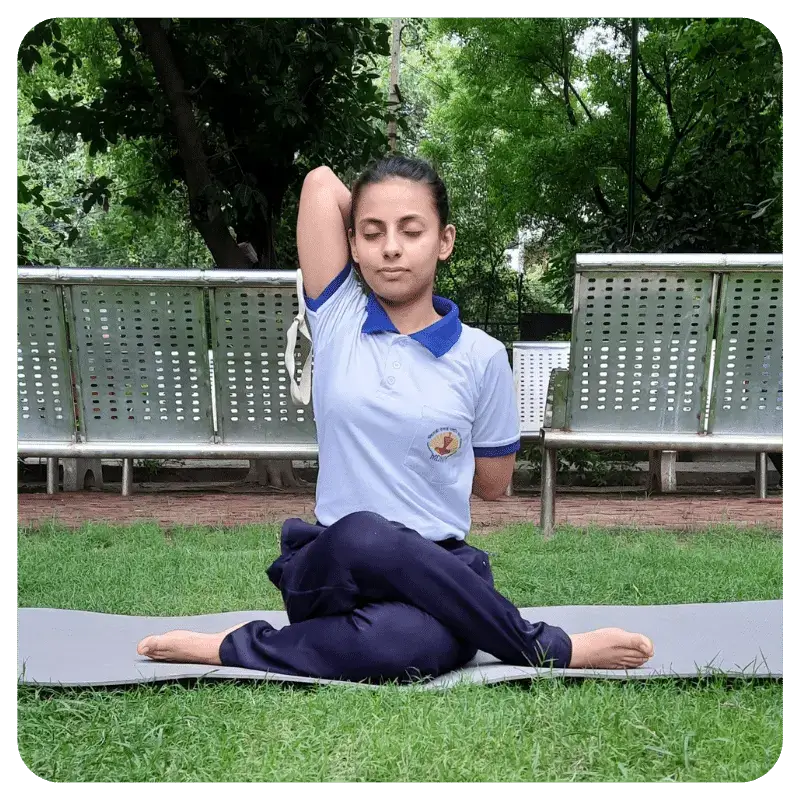
About The Author
Ankita Sapra is a government-certified Yoga Instructor with diploma in Yoga Science and has also completed her Instructor course from SVYASA, Bangalore and has cleared YCB Level 3 (Teacher and Evaluator) exam.
More About Ankita
